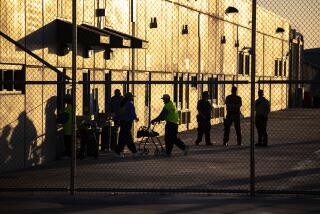County acts to handle inmate influx
- Share via
The population of Los Angeles County’s jails has swelled significantly in the last few months due to an influx of prisoners, forcing officials to look as far as the Central Valley for places to house them.
Since last fall, the state has shifted more than 5,000 inmates who would previously have been housed in state prisons to Los Angeles’ jails under a program known as “realignment.” The county’s jail system, the nation’s largest, now holds about 18,600 inmates, and officials are concerned about overcrowding unless they can find alternative locations for the prisoners.
The Sheriff’s Department is in discussions with two Kern County cities to use their currently empty jails to house up to 1,000 low-level offenders and is considering talks with two other cities.
At the same time, some officials have floated the idea of the county taking over fire camps across California that are operated by the state and placing additional inmates in them. It’s unclear, however, if the county has enough funding to do so.
Those moves are likely to be the first in a series of efforts to deal with the increased jail population brought on by realignment, the controversial state law that is designed to address a U.S. Supreme Court order to improve conditions in California’s prisons. The shift has increased the jail populations in counties across the state, with some counties resorting to early release to avoid overcrowding.
In an interview Monday, Assistant Sheriff Cecil W. Rhambo Jr. said the department is considering several other strategies for dealing with the rising inmate population, including releasing more women with electronic monitoring systems. The Sheriff’s Department has also been discussing with court officials, prosecutors and defense attorneys the idea of speeding up the resolution of some lower-level criminal cases.
Most inmates in the jails are awaiting trial.
Rhambo said the department is considering using electronic monitoring rather than jail detention for some defendants accused of drug crimes and prostitution.
Sheriff’s officials project that the jail system will run out of space by Christmas. Rhambo said he was hopeful that the deals with Kern County cities would be finalized by the fall.
When asked by The Times last year about the prospect of sending inmates to a facility outside the county, sheriff’s officials strongly downplayed the idea, saying that it would only occur under extreme circumstances.
The towns of Shafter and Taft both have city-owned jails that could house about 1,000 prisoners in all.
John Guinn, Shafter’s city manager, said his city’s jail is available because it was closed down several month ago as a result of budget cuts.
Sheriff’s officials said they are also talking to two other Central Valley communities, Coalinga and Delano, about moving an additional 1,000 inmates to facilities there.
It would cost an estimated $61 a day to house an inmate in Kern County, compared to $113 in L.A. County.
“It’s pretty important to look for cost-effective bed space,” Rhambo said. “People are very concerned about realignment. We want to be able to assure public safety and hold the realigned population to the time they were committed to.”
Sheriff’s Department spokesman Steve Whitmore emphasized that no changes have yet been made to the county’s early release policy. That policy calls for nonviolent offenders to serve 20% of their jail terms, although Whitmore noted that documented gang members will serve their full sentences. Other violent offenders sentenced to jail serve 75% of their terms, Rhambo said.
Los Angeles has benefited from having a sprawling jails system with the capacity to add more inmates. Before realignment began, Los Angeles County jails showed the largest drop in inmate population of any jail system in the nation, according to a U.S. Justice Department report.
That study found that Los Angeles County’s inmate population dropped by more than 3,000 during a yearlong period ending in June 2010.
Los Angeles County will also get some relief when officials reopen parts of the North County Correctional Facility this fall.
--
jason.song@latimes.com
More to Read
Sign up for Essential California
The most important California stories and recommendations in your inbox every morning.
You may occasionally receive promotional content from the Los Angeles Times.














